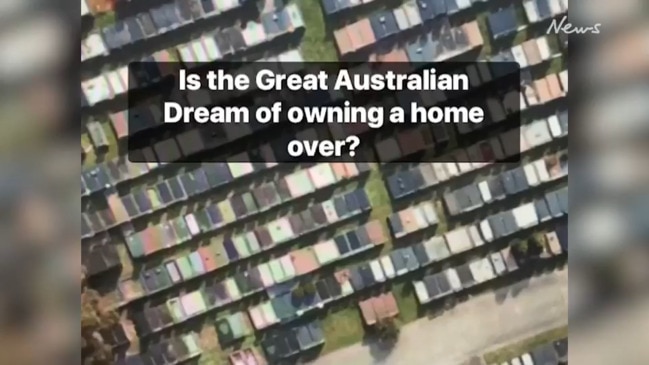Key fact Albo’s missing in housing crisis
The huge gulf between what Aussies want in a home and what the government thinks they want needs to be bridged if the housing crisis can ever be solved.

Property
Don't miss out on the headlines from Property. Followed categories will be added to My News.
The dream of a house on a quarter-acre block is all but dead for many Australians priced out of the market, pushing them to invest in apartment living instead.
With housing affordability at crisis point and more people choosing compact urban living, experts are calling for immediate, comprehensive action to redirect housing development away from “outdated” greenfield projects on city fringes.
The Australian Institute of Architects national president Stuart Tanner says there is an urgent need for proactive measures due to skyrocketing land prices, construction costs, sustainability concerns, and overall living expenses.
“About 40 per cent of all waste per head in Australia is construction waste,” Tanner says.
“Australia has the largest houses per metre squared for the number of people in the world, so if you could produce four or six apartments on a lot instead of a very large house, then surely that’s better for the environment (and) community, and bring about a denser, more vibrant city.”

He says it is a necessity for the “Great Australian Dream” of home ownership to evolve with governments playing a proactive role in reshaping housing strategies, moving away from unsustainable sprawl. This involves adopting inclusionary zoning initiatives to encourage denser urban living and affordable housing in city areas.
Tanner says exceptional architecture and design are essential in creating healthier and more vibrant living environments.
Housing Industry Association senior economist Tom Devitt says Australia has been trending towards higher density living, but the Covid pandemic temporarily reversed this trend.
“The pandemic made people want more space and amenity in their living environments, given how much extra time we were spending at home,” he says.
“This drove people away from small apartments into larger units and houses, even out of the capitals into the regions.”
But Devitt says this trend is expected to reverse again in the coming years due to the “acute shortage of shovel ready land in Australia’s capitals”.
He says the benefits of higher density development include infrastructure optimisation, streamlined services, reduced urban sprawl, and vibrant communities.
“Higher density living is crucial to meeting Australia’s current and future needs for affordable housing,” Devitt says.
RELATED: Why landlords are the solution, not the problem to housing ills
“The challenge facing higher density development is policy, rather than demand.”
He says Australian Prudential Regulation Authority restrictions and state surcharges discouraged investors during the previous apartment boom, with local planning constraints raising costs and causing a substantial decline in higher density construction over the past seven years.
City Futures Research Centre of the University of NSW, research associate Dr Sophie-May Kerr says well-designed apartments are crucial for families to be attracted to urban living. She says key aspects such as affordable larger apartments, effective sound proofing, flexible space design, ample storage and safe communal play areas are crucial for urban planners to prioritise.
“Unfortunately, our research with families living in apartments, reveals that design and acceptance of families in this setting has not kept pace with demographic shifts,” she says. “The mismatch between what families want and what is available, is a planning challenge that must be addressed if the compact city agenda is to be successful for a diversity of residents, including families.

MORE: Secret negotiating tips for homebuyers
“The location of apartments and surrounding neighbourhood also matter. Public infrastructure and availability of ‘third spaces’ such as cafes, libraries and parks impact on residents’ satisfaction and ability to connect within their communities.
“If we want to foster healthy built environments we need to put people and communities at the centre of planning before profit.”
Stefania Reynolds, project architect and head of interiors at Studio Johnston, bought a three-bedroom inner-city unit in Sydney below her budget.
She was then able to afford a renovation to transform the “unpleasant living space” into an intelligently designed home accommodating the needs of her family-of-four.
“I found this (unit) and I turned my nose up at it as an architect (but) I had to move past the hideous interiors and think ‘the bones are there … the space is there, I can transform this’,” Reynolds says.
The renovation created an open environment with ample storage, a designated home office and seamless zones which catered to her family’s activities and interests.
“I absolutely love it, It has literally transformed my life,” Reynolds says.
“I feel connected to my family because the plan works as a Venn diagram and the spaces overlap. It’s efficient, I have storage, I can put the pram away so I don’t have to look at it every day. I have a little piece of outdoor space and there’s beautiful lighting.”
Reynolds says steering away from the societal pull of owning a large home was something she would never look back on.
“When you actually research what makes people happy, while your genes make up an estimated 40 per cent of your happiness, the rest is determined by how we live our lives,” she says.
“So you feel happiness when you have a roof over your head, warmth, love, the amenities you need, and a sense of community.
“You can have the biggest home and be totally isolated in this concrete bunker that will not bring you happiness.
“So buy the unit if that’s what you can afford, as long as it’s in a location that makes you happy and then start imagining how you could transform it to suit your family needs.”
More Coverage
Originally published as Key fact Albo’s missing in housing crisis





